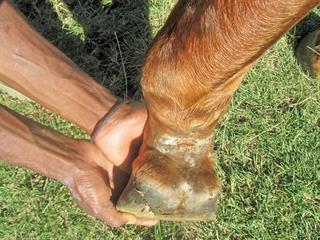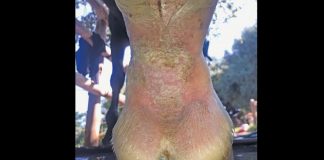
The stripe-leg or hyalomma tick (Hyalomma rufipes) is common among cattle, sheep, goats and game in Southern Africa. It has long mouthparts and hunts its prey by scuttling along the ground, almost like a spider. The immature tick is a dark brown colour with long, striped legs. It is a two-host parasite and the immature stage is found on guinea fowl, ostriches, scrub hares and hedgehogs.
Like many ticks, the engorged adult is a dark grey colour, but the striped legs are still very obvious. The hyalomma is known to carry Crimean Congo fever, but the adults do not usually bite humans. However, if you crush or pull out one of these ticks, you can become infected. It can also carry Babesia caballi, the cause of acute biliary fever.
In South Africa, the effect of these ticks on horses is not well understood, but the same toxins that cause sweating sickness in calves and terrible wounds in dogs can also result in pain and lameness in horses. This year, because of the heavy rains, the veld grass is lush and ticks seem to be much more prevalent than normal. Horse owners are accustomed to coping with the red-legged tick, which occurs mainly on the neck, body and under the tail, and the brown ear tick, which occurs on the poll, but not with the stripe-leg tick.
Prevention
These long-mouthed ticks prefer to settle into the hair and folds of the pastern, just behind and under the fetlock. They also favour the end of the tail, where they are almost invisible among the tail hairs. Often they creep into the folds of skin behind the elbow or high up on the hind leg, and occasionally, they fix themselves onto the mane. The horse will frantically rub off its own hair to try to remove them. Most horse owners use Cypermethrin and Deltamethrin dips for tick and midge control, but these appear to have little or no effect on the hyalomma tick.
How to treat the problem
A better option may be tick grease, but only those containing organophosphates seem to be effective. Apply a thick layer behind the pasterns, between the belly and hind legs, under the elbows and at the root of the tail. Carbamates also appear to be effective and can be applied as a powder or spray dip, concentrating on the sites that the ticks prefer.
Hyalomma ticks should never be pulled off, as their long mouthparts often remain behind. Instead, mix carbamate insecticidal powder with Vaseline and apply thickly over the ticks attached to the skin of the mane and tail-tip, or behind the pasterns. The parasites will then die and fall off.
To treat swelling and lameness, soak the affected hoof and pastern in a solution of Epsom salt (four tablespoons/l).
Cortisone ointment, obtainable from your vet, can be rubbed into bites in the mane, tail and elsewhere. If necessary, inject cortisone to reduce the effects of the toxic effects of bites. Wounds caused by the bites can be treated with antibiotic powder and injections.













